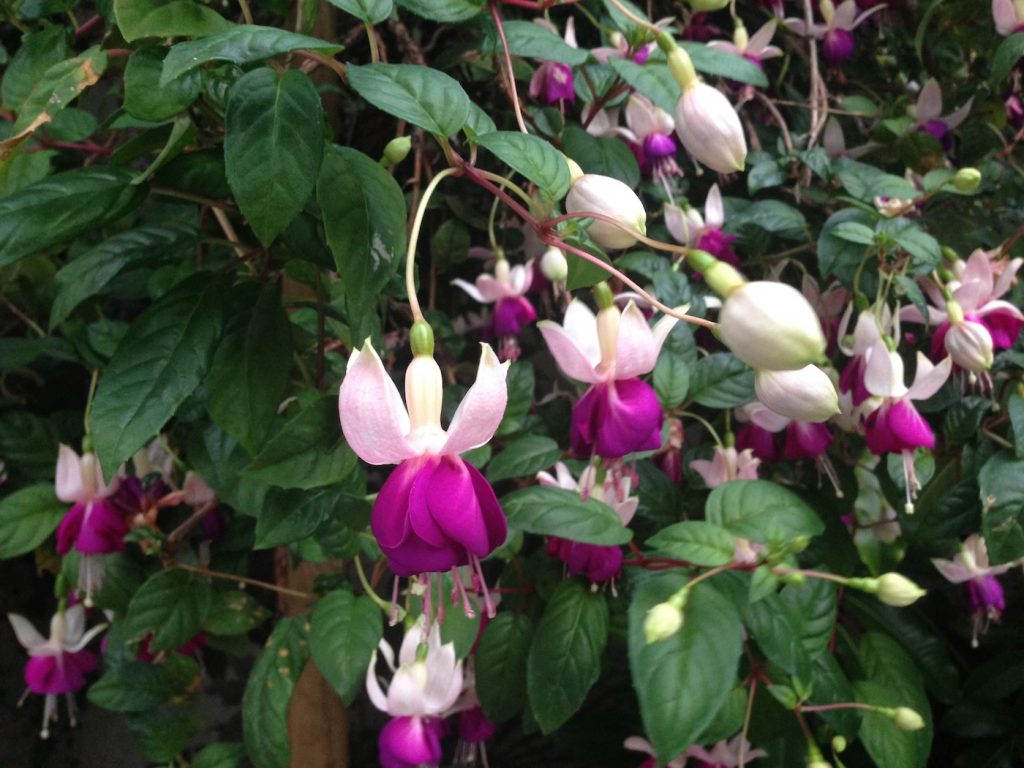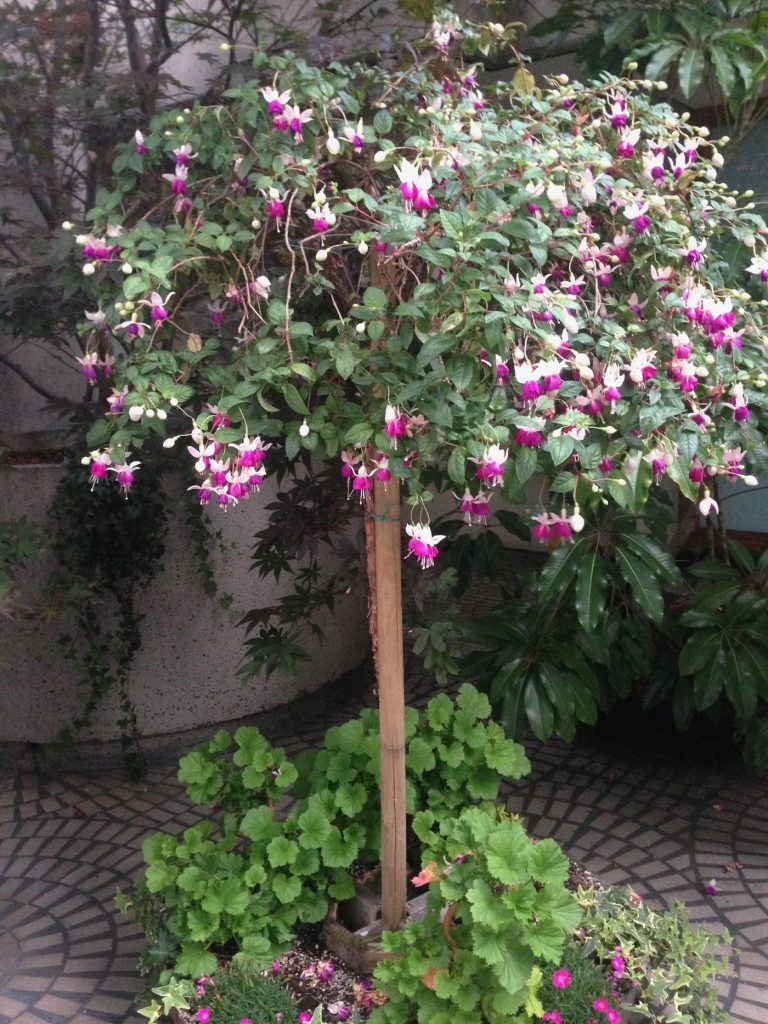Fuchsia ‘Old Berkeley’: A Garden Gem with a Rich History
Fuchsia ‘Old Berkeley’ is a delightful addition to any garden, and it comes with a rich history. In 1955, this exquisite fuchsia was hybridized by the father-son duo of Victor Reiter Sr. and Victor Reiter Jr., hailing from San Francisco. Their creation, known as Fuchsia Berkeley, features profuse blossoms in pale rose over a darker rose double with a lax growth habit. This remarkable fuchsia even earned a Certificate of Merit from the Society, a testament to its outstanding qualities. Over the years, Fuchsia Berkeley has remained available to garden enthusiasts, occasionally found at fuchsia nurseries.
Description and Family:
Belonging to the Onagraceae family of plants, Fuchsia ‘Old Berkeley’ is a perennial shrub known for its elegant evergreen presence in your garden. This compact shrub typically reaches a mature size of approximately 18-24 inches in height, making it an excellent choice for those seeking a manageable and visually appealing addition to their outdoor space.
The most striking feature of Fuchsia ‘Old Berkeley’ is its pendulous teardrop-shaped blossoms. These unique flowers are adorned with deep matte purple corollas beneath white sepals, which are charmingly tipped in green. The contrast between the corollas and sepals creates a captivating visual display that graces your garden throughout the year. The blossoms are relatively small, measuring about 2 inches in size, but they appear prolifically, ensuring that your garden is always adorned with their beauty.
Growing Conditions for Fuchsia ‘Old Berkeley’:
Fuchsia ‘Old Berkeley’ is a relatively easy-to-grow plant, provided you offer it the right growing conditions. Here are some important factors to consider:
1. Sunlight: This fuchsia variety thrives in locations with part sun to part shade. To help it flourish, ensure it receives the right amount of sunlight.
2. Water: While Fuchsia ‘Old Berkeley’ has medium water needs, it’s essential to water it regularly. However, be cautious not to overwater, as excessively moist soil can lead to problems. The soil should remain consistently moist, so avoid letting it dry out between waterings.
3. Soil: Plant Fuchsia ‘Old Berkeley’ in sandy loam soil to provide it with the ideal growing medium for its development.
Blossom Details:
The beauty of Fuchsia ‘Old Berkeley’ is best expressed through its charming flowers. The color palette of these blossoms includes shades of rose, mauve, and magenta (pink-purple), which add a touch of elegance to your garden. These teardrop-shaped flowers are decorative and captivating. They appear profusely throughout the summer and autumn, creating a continuous source of beauty for your garden. In tropical species, the blooming can continue year-round, providing a constant spectacle.
Attracting Wildlife:
Fuchsia ‘Old Berkeley’ doesn’t just enhance the aesthetic appeal of your garden; it also attracts wildlife. Bees, butterflies, and birds are drawn to the captivating blossoms, making it an ideal addition for gardeners aiming to create a lively and vibrant garden ecosystem.
Fruits:
While Fuchsia ‘Old Berkeley’ produces fruits, it’s worth noting that they are edible but not particularly appetizing. The real allure of this shrub lies in its blossoms and its visual appeal in your garden.
In conclusion, Fuchsia ‘Old Berkeley’ is a plant that effortlessly brings elegance and beauty to your garden. Its distinctive blossoms, alluring color palette, and the wildlife it attracts make it a valuable addition to any garden. With the right care, you can enjoy its year-round beauty and add a touch of charm to your outdoor space. Whether you’re an experienced gardener or just starting, this evergreen shrub can be a delightful choice for your garden.
Caring for Fuchsia ‘Old Berkeley’:
Maintaining Fuchsia ‘Old Berkeley’ is relatively straightforward, but it’s essential to follow a few guidelines for its well-being:
1. Pruning: Occasional pruning is necessary to maintain the shrub’s shape and extend its lifespan. Pruning should typically be done in the spring, especially for plants exposed to mild winters. This practice also helps remove dead or broken branches.
2. Mulching: If you’re growing Fuchsia ‘Old Berkeley’ in an area with cold winters, it’s advisable to mulch heavily. Mulch helps protect the plant’s roots and keeps them from freezing during winter.
3. Propagation: Fuchsia ‘Old Berkeley’ can be propagated from softwood cuttings. Keep in mind that this plant does not typically set seed, and even if it does, the resulting plants may not come true from seed. Therefore, cuttings are the preferred method for propagation.
Pests and Disease:
Fuchsias, including Fuchsia ‘Old Berkeley,’ are susceptible to various pests and diseases. Here are some common issues you may encounter:
Pests:
Aphids: Aphids are tiny, soft-bodied insects that can cluster on fuchsia leaves and flowers, causing damage by sucking plant sap. They often leave behind a sticky substance called honeydew, which can attract other pests.
Whiteflies: Whiteflies are small, winged insects that feed on the undersides of fuchsia leaves. They can weaken the plant by sucking its juices and can transmit plant viruses.
Spider Mites: These tiny arachnids are known for creating fine webbing on the plant and feeding on fuchsia leaves. They can cause stippling, yellowing, and even leaf drop.
Mealybugs: Mealybugs are small, white, cottony pests that feed on plant sap. They often infest fuchsia shoots and leaf nodes.
Thrips: Thrips are slender insects that can damage fuchsia flowers and leaves by scraping and sucking plant tissue. They can cause silvery streaks and distortion on the foliage.
Fuchsia Gall Mite: This mite is a specific pest of fuchsias and causes distorted growth, often resulting in a gall-like appearance on the leaves and flowers.
Diseases:
Fuchsia Rust: Fuchsia rust is a fungal disease that causes rust-colored pustules on the undersides of fuchsia leaves. It can lead to leaf drop and weaken the plant.
Gray Mold (Botrytis cinerea): This fungal disease affects fuchsia flowers, causing them to become discolored, rot, and turn mushy. It can spread rapidly in damp conditions.
Powdery Mildew: Powdery mildew is a fungal disease that appears as white, powdery spots on fuchsia leaves and stems. It can distort new growth and reduce plant vigor.
Leaf Spot Diseases: Fuchsia plants can be susceptible to various leaf spot diseases caused by fungi or bacteria. These diseases typically manifest as dark spots on the leaves and can weaken the plant.
Control and Prevention:
- Pruning: Regularly prune your fuchsia to improve air circulation and remove diseased or infested plant parts.
- Watering: Water at the base of the plant to keep foliage dry, as many fungal diseases thrive in humid conditions.
- Insecticidal Soap: Use insecticidal soap or neem oil to control aphids, whiteflies, and mealybugs. Apply as directed on the product label.
- Biological Controls: Beneficial insects like ladybugs and lacewings can help control aphids and other pests.
- Fungicides: Fungicides can be used to control fungal diseases like rust and powdery mildew. Follow the label instructions for proper application.
- Isolation: If you suspect a pest or disease issue, isolate the affected plant to prevent the problem from spreading to other fuchsias.
- Good Garden Hygiene: Remove fallen leaves and debris from the base of the plant to reduce disease sources.
Remember to regularly inspect your Fuchsia ‘Old Berkeley’ for signs of pests and diseases and take prompt action to control and prevent any issues to keep your plant healthy and thriving.
In Conclusion:
Fuchsia ‘Old Berkeley’ is not just a garden gem; it’s a piece of horticultural history. With its captivating blossoms, pleasant fragrance, and the fascinating backstory of its hybridization, it stands as a living testament to the art of plant breeding. This evergreen shrub effortlessly brings elegance and charm to your garden, making it an ideal choice for garden enthusiasts, whether you’re an experienced gardener or just starting. By selecting Fuchsia ‘Old Berkeley,’ you’re not only adding a touch of natural beauty to your outdoor space but also welcoming a piece of botanical history to flourish in your garden.






